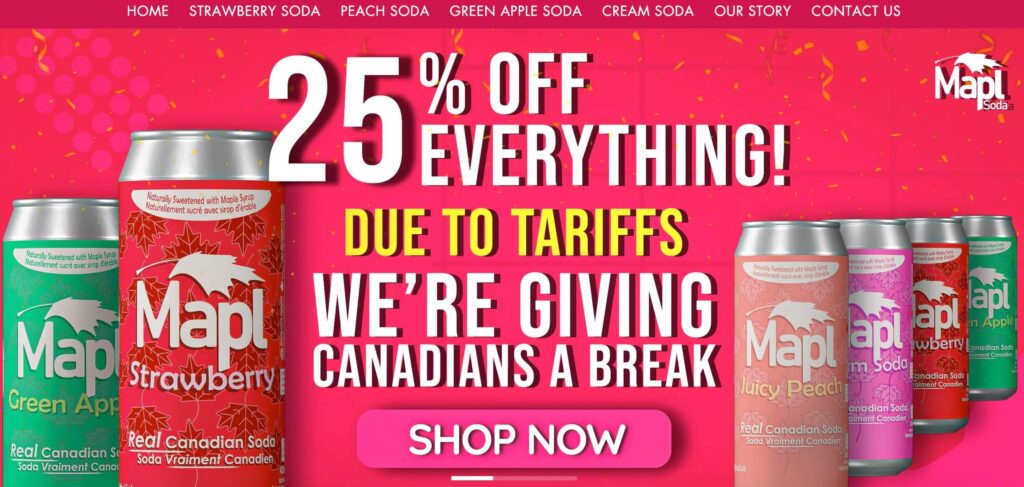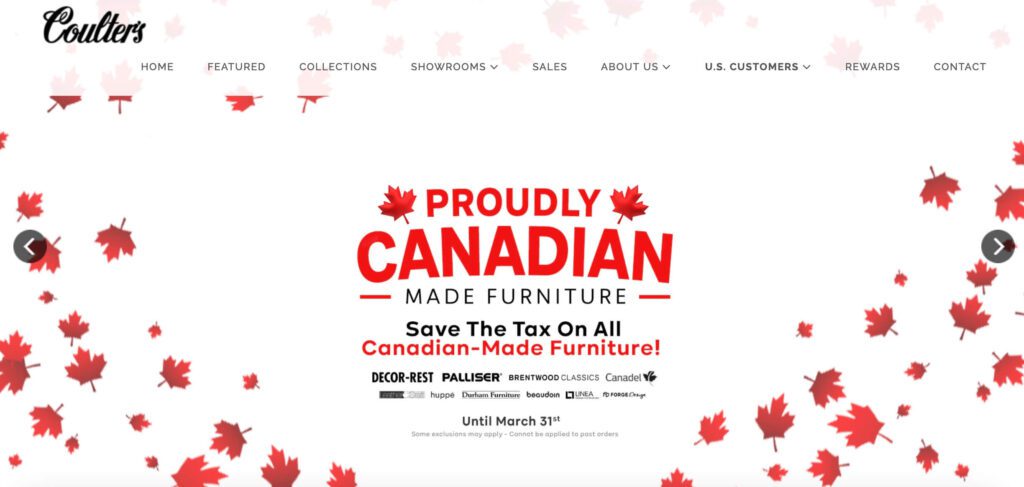U.S. Tariffs: How Brands Are Newsjacking Tariffs in Their Ads
The recent imposition of U.S. tariffs has sent shockwaves through global trade. Businesses in Canada, Mexico, and China have been forced into instantly adapting to the changes that come with this move.
Some brands are scrambling to rethink their business models, shifting operations to tariff-exempt regions or renegotiating supplier contracts. Whereas others are seizing the moment as a marketing opportunity.

Some are cutting back on ad spending. Whereas others are merely diverting focus to reinforce their local presence and target their local audience more effectively.
A few brands are also newsjacking the tariff situation using it as a theme in their marketing narrative and launching creative campaigns that resonate with customers.
So, today we’re exploring the strategies of these brands. We’re talking about companies that are capitalizing on the tariff discussion with inventive marketing strategies to address consumer concerns and elevate their brand identities in uncertain times.
- Adapting to Change: How Are Brands Responding to U.S. Tariffs
- 1. Discounts & promotions – turning tariffs into savings
- 2. Giveaways to grab attention
- 3. Focus on local marketing
- 4. Social media & influencer campaigns
- 5. Focus on the long-term
- 6. Expressing solidarity through merchandise
- 7. Reinforcing national pride
- 8. Joining the protest
- 9. Cutting marketing budgets
- 10. Diversifying operations as a future-proofing step
- The Path Forward: Adapting to Changes & Seizing Opportunities
Adapting to Change: How Are Brands Responding to U.S. Tariffs
Political moves like the U.S. tariff announcement tend to have a huge impact on the economic situation. This is because the revised tariffs lead to an increase in production costs, disrupt supply chains, and eventually lead to price hikes. Consumers have to bear the brunt and consequently, their shopping behaviors change drastically.
For instance, the uncertainty and the strong signals that car prices will increase soon due to tariffs have caused car buyers to rush to dealers. With all these impactful consequences to look out for, several brands have responded. Here are a few patterns we observed.
1. Discounts & promotions – turning tariffs into savings
Using the U.S. tariffs as a hook, several Canadian brands have announced sales and discounts on their products.
For instance, Pizza Pizza announced a 25% off on regular-priced pizzas as a part of their “Reverse Tariff” campaign. The video here uses humor to communicate the message and provide customers with a promo code.
Another brand riding the wave is Mapl Soda. They too have announced a 25% off on their products and their website homepage announces this discount in addition to proudly labeling themselves the “true Canadian soda”. In addition to responding to changing shopping behaviors, this campaign also reinforces the brand’s local origins thus resonating with the Canadian audience.
Finally, there’s Flair Airlines offering “tarrific” deals on a few domestic and international flights.
Campaigns like these can be productive because they feel like a direct and relevant response to the trade tensions. Moreover, they are appealing to customers who feel the pinch of increased costs.
2. Giveaways to grab attention
Giveaways are great when you have to create a buzz. Therefore, some brands looking to cut through the noise amidst the U.S. tariff chaos have announced giveaways.
For example, the below post announces a gift card reward and the rules are simple. Also, the brand clearly delivers the message of supporting local.
Giveaways are good when you have to take a different approach and focus on engagement. In this case, brands benefit from offering tariff-free prizes that address consumer concerns over rising prices.
3. Focus on local marketing
Some Canadian brands with a broader presence have now shifted their focus to prioritize local audiences. Additionally, brands are strategically emphasizing their Canadian origins. As a result, the “Buy Canadian” movement has gained traction.
Consumers in the countries affected by U.S. tariffs, like Canada, are focusing on supporting the local economy. Hence brands are emphasizing their Canadian origins like the homepage announcement on the site here.
Stores are also labeling local products to make it easier for Canadians to find locally made items that are not going to be heavy on their pocket.
That was quick!
— Polymarket Intel (@PolymarketIntel) February 2, 2025
After Trump’s tariffs on Canada, stores across the country began discouraging customers from buying American products by labeling items with “Made in Canada” and urging shoppers to “Buy Canadian instead.” pic.twitter.com/V3vSJQ84Bm
Even brands like Walmart have started displaying “Made in Canada” labels to make shopping from local brands easier. For American brands in Canada, like Walmart, keeping up with the changes that are coming can be tough. This is just one way in which the brand is trying to be flexible.

Loblaw, a major Canadian grocery chain, introduced a symbol on products impacted by tariffs, helping customers easily identify items affected by trade policies. This transparency builds trust while encouraging shoppers to choose local alternatives.
During times of uncertainties like this one, transparency can be a huge benefit. By being transparent you are helping your customers understand the situation and make informed choices. It also aligns with the changing shopping preferences and gives a boost to local vendors.
4. Social media & influencer campaigns
Social media channels like X are the go-to platforms for news content. Therefore, there has been a surge in the discussions around U.S. tariffs on X Instagram and other channels. Tapping into this, brands are also initiating conversations, promoting their local products, and connecting with their audience through social media.
For example, McCall’s, a popular baker in Canada, shared the below post giving a preview of their processes. It also highlights the brand’s Canadian roots and how the products are sourced and made locally. Amidst the growing affinity toward locally made products in Canada, as a move to reduce costs, highlighting your processes through social media can be a great move.
In addition to this, the influencer collaboration scenario has changed too. While the increased budgets possibly affecting marketing budgets is one thing, what truly stands out is the kind of message that influencers deliver through brand collaborations.
Brands are now in a situation to be more strategic about choosing the right influencers and exploring more affordable collaborations with micro-influencers and nano-influencers.
To know more about the right influencers to choose, check out our blog on types of influencers.
5. Focus on the long-term
A common trend is that the recent market volatility and price inflation have pushed customers and brands to think long-term. In short, businesses are prioritizing resilience and consumers are thinking more about choosing products that last long instead of trends that fade away instantly. This could probably lead to some big changes in industries like fast fashion where it is all about frequent purchases.
An Ontario-based food company, Nutrafarms is addressing the issue of increasing food prices while also helping customers shop local.
Their “3-year price lock guarantee” allows customers to choose a list of everyday essentials and lock their current-day price all the way up to 2028. The idea is to provide consumers with better control over their food expenses. One less thing to worry about when the prices of most products are increasing.
6. Expressing solidarity through merchandise
One of the main reasons why both consumers and brands are making the switch to local is because major economic moves like these can affect the livelihoods of many. Hence brands are promoting merchandise that expresses solidarity with local communities and highlights their commitment to supporting Canadian businesses.
When these are in the form of everyday accessories like hats and t-shirts, it also allows consumers to join the move and make a statement.
Particularly, there has been a surge in the sale of “Canada is not for sale” hats, and several local retailers in Canada have stocked up on these.
In addition to establishing the message clearly, most of these also feature Canadian symbols such as the maple leaf or even the national colors, appealing to consumers’ sense of national pride.
7. Reinforcing national pride
In Canada, some brands and well-known personalities are also newsjacking the U.S. tariffs discussion by doubling down on the celebration of Canadian identity. They have been trying to foster unity and pride among consumers creating positive and inspirational narratives amidst the looming fear over rising prices.
A standout example is the “We Are Canadian” video featuring Jeff Douglas. This video infuses satire into storytelling to establish a strong message much-needed for the moment.
The video is a revamped version of Douglas’s iconic “I Am Canadian” rant from a Molson Canadian beer ad from 25 years ago. The content has been updated to address current tensions between the U.S. and Canada.
8. Joining the protest
While businesses have embraced the changes and adapted to them, they have not shied away from joining the protest and expressing their disappointment.
The “Canadiano movement” in the coffee shop sector is one such. Some coffee shops in Canada have renamed the Americano on their menu to Canadiano. In fact, a popular Canadian brand called Kicking Horse Coffee has been calling Americano coffee “Canadiano” for almost 16 years now. And the recent political situation has caused this trend to blow up.
Reportedly, other coffee shops like Café Belem and Le Petit Pain have also brought Canadianos into their menu joining the silent resistance.
While playful and subtle, this rebranded presentation of a well-known beverage is a clever way for these coffee shops to grab attention and engage with their customers. By doing so, they have managed to convert a simple beverage into a symbol of national pride. In a way, such measures can be a great way for brands to foster community spirit during unpredictable situations like the one brought in by the U.S. tariffs.
9. Cutting marketing budgets
While some brands have created campaigns like the ones we discussed so far, another common trend is that brands are cutting their marketing budgets. The rising costs due to U.S. tariffs call for a conversation of resources in order to prepare for the financial instability that might ensue.
Pulling back on advertising is mainly because old strategies do not matter anymore given that the target markets are now shifting and the messaging strategies are changing as well. Refined objectives mean refined strategies and this can add an extra burden on the marketing budgets. Many brands might not be ready for this when navigating unpredictable trade scenarios like the one that exists now.
But yes, like the approach adopted by brands on our list, taking a different path or optimizing the current one to make it more relevant to the context is a better way to handle the situation. That’s why brands are mostly focusing on high-impact strategies and campaigns that immediately attract attention and drive action.
For instance, the post here from the popular mobile accessories brand Pela Case demonstrates how simple yet noticeable changes to the brand message can yield good results. Their post here looks like most other posts from the brand but this one appears relevant to the current situation by highlighting the fact that the Canadian-made products from the brand do not attract tariffs.
10. Diversifying operations as a future-proofing step
In addition to the immediate steps, some brands are also rethinking their operations in order to achieve a long-term fix. After all, having a contingency plan helps during such unprecedented market conditions.
This includes re-evaluating production strategies, supply chains, and the location of manufacturing units in order to mitigate financial risks and stay ready to explore new markets.
Honda, for instance, is considering moving the manufacturing of the next Civic model to Indiana from their initial choice, Mexico. This is mainly because Mexico is also one of the countries likely to take a big hit due to the U.S. tariffs.
Similarly, let’s talk about one brand that diversified earlier and hence managed to mitigate the situation, Lululemon. Despite being a Canadian brand, a majority of their manufacturing happens outside Canada and hence they might be able to avert a direct hit.
However, a similar Canadian brand, Canada Goose, has most of its manufacturing happening in Canada. Hence their products will be subject to the new tariffs during export to the U.S.
Examples like these highlight the need for international brands to consider market uncertainties and diversify their operations and assess their supply chains in order to gain resilience.
The Path Forward: Adapting to Changes & Seizing Opportunities
In conclusion, the revised U.S. tariffs are pushing brands to think creatively and adjust their marketing and messaging strategies. The key is to stay authentic and stay relevant to the situation. Brands that keep this in mind and adapt are the ones that can thrive.
What other shifts will emerge in the global marketplace as companies navigate these challenges? Only time will tell.



